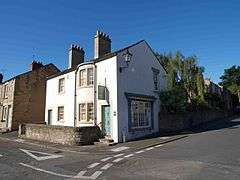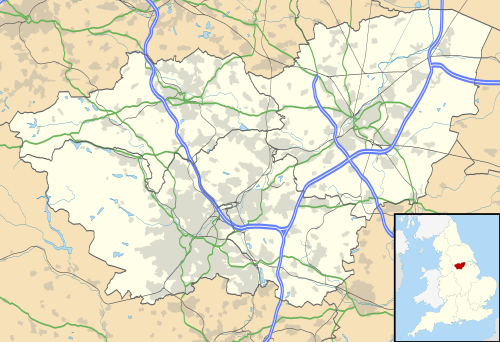Darfield, South Yorkshire
| Darfield | |
 Darfield museum |
|
 Darfield |
|
| Population | 10,685 (Ward. 2011) |
|---|---|
| OS grid reference | SE411048 |
| – London | 150 mi (240 km) SSE |
| Metropolitan borough | Barnsley |
| Metropolitan county | South Yorkshire |
| Region | Yorkshire and the Humber |
| Country | England |
| Sovereign state | United Kingdom |
| Post town | Barnsley |
| Postcode district | S73 |
| Dialling code | 01226 |
| Police | South Yorkshire |
| Fire | South Yorkshire |
| Ambulance | Yorkshire |
| EU Parliament | Yorkshire and the Humber |
| UK Parliament | Barnsley East |
Coordinates: 53°32′17″N 1°22′52″W / 53.538°N 1.3812°W
Darfield is a village within the Metropolitan Borough of Barnsley, South Yorkshire, England. Historically part of the West Riding of Yorkshire. The village is situated approximately 4 miles (6 km) east from Barnsley town centre. Darfield had a population of 8,066 at the 2001 UK Census,[1] increasing to 10,685 at the 2011 Census.[2]
History
Roman coins have been unearthed in Darfield, and there is evidence to suggest that the village contained Roman habitation during its history.
In Saxon, the name "Feld" describes 'a large area of pasture land' , while the term "Dere" refers to the deer which inhabited the forest. When combined, this gives the name Derefeld which later became Darfield.
There are records of an 8th-century church in Darfield, but when the Domesday Book was written in 1086 there was no mention of it.
Darfield remained an insignificant agricultural village for many centuries to come, until 1862. In that year, two mining companies sank shafts in the Barnsley district to exploit the rich seam of coal running through the area. Darfield Main colliery and Mitchell's Main were local mines, the population of the village quickly increased and it became a labour pool for the surrounding coalmines. By 1901, over 4,000 people lived there compared to just 600 inhabitants in 1851.
Until June 1963, Darfield had a railway station on the former Midland Railway's Sheffield Midland - Cudworth - Leeds City line. The line itself closed in 1988 due to severe subsidence.
Community
Darfield shops include a Co-op supermarket, a florist's, baker's, newsagent's, two hairdresser's, garage/MOT station, a post office, greetings card shop, and a hardware & homeware shop. Two village chemists are based inside the local doctors' surgery and on Snape Hill Road. Food outlets include two Indian restaurants (formally The Bridge Inn and The Station public house) two takeaway cafes, two fish and chip shops, a Chinese takeaway and a pizzeria.
Darfield is the home to the Maurice Dobson museum which is divided into four parts: the main museum, an outlet area where local people can sell their craft items, a cafe/gallery, and a meeting place.[3] There is also an outdoor patio where some larger items are exhibited. The museum's property was donated to the village by Maurice Dobson, after whom the museum is named. There is also a small village public library. Religion is served by an Anglican parish church and two Methodist chapels.
Transport
Stagecoach Yorkshire operate bus services every 15 minutes to Barnsley during the daytime as well as 2 buses per hour to Wombwell. Darfield is also served by the express bus service X19 which operates direct to Doncaster and Robin Hood Airport. Also, both Wombwell and Goldthorpe railway stations are within easy reach of Darfield where connections can be made to Sheffield, Meadowhall, Wakefield and Leeds.
Education
Darfield schools include:
- Darfield Upperwood Academy, a 4–11 primary school, opened on 5 November 1973,[4] that educates around 250 pupils. In July 2006 it was reported in the Barnsley Chronicle that a special investigation by council auditors into the school accounts raised questions about the way it was using public money. This received national media coverage when it appeared in the Yorkshire Post in March 2007.[5]
- Darfield Valley Primary School, Snape Hill Road, Darfield.
- All Saints' Academy (formerly Darfield All Saints' Primary School), a Church of England primary school with academy status. Located on School Street, Darfield.
- Netherwood Advanced Learning Centre a secondary school formed in September 2012 from a merger between Darfield Foulstone School and Wombwell High School.[6] Darfield Foulstone School of Creative Arts, Nanny Marr Road, Darfield, no longer exists, because it was demolished at the beginning of 2013 following the opening of the Netherwood Advanced Learning Centre.
Sport
Darfield has a cricket club which plays at Darfield Cricket Ground and a junior football team which is Darfield JFC, they have played on the Longbow playing fields former Darfield Foulstone School Fields for the last 21 years.
The village has had a team play in the FA Cup before - Darfield F.C. Its nearest professional football club is Barnsley F.C. based in the city centre of the metropolitan borough.
Notable people
- Ian McMillan, poet and broadcaster.[7]
- Brian Key, former MEP for Yorkshire South and former councillor for the ward
Steven Lancaster. Chemist and one of the Royal Society of Chemistry's 175 'Faces of Chemistry.
See also
References
- ↑ "Census 2001 : Urban Areas : Table KS01 : Usual Resident Population". Office for National Statistics. Retrieved 26 August 2009.
- ↑ "Barnsley CBC Ward population 2011". Neighbourhood Statistics. Office for National Statistics. Retrieved 4 March 2016.
- ↑ Maurice Dobson museum
- ↑ "Upperwood Primary School" (PDF). Barnsley Council. 2003. Archived from the original (PDF) on 27 September 2007.
- ↑ Reed, James (26 March 2007). "Inquiry urged over four-star spending at primary school". Yorkshire Post.
- ↑ "The Foulstone School - Inspection report" (PDF). Ofsted. 11 June 2007.
- ↑ Forbes, Peter (2002). "Ian McMillan". British Council.
External links
 Media related to Darfield, South Yorkshire at Wikimedia Commons
Media related to Darfield, South Yorkshire at Wikimedia Commons